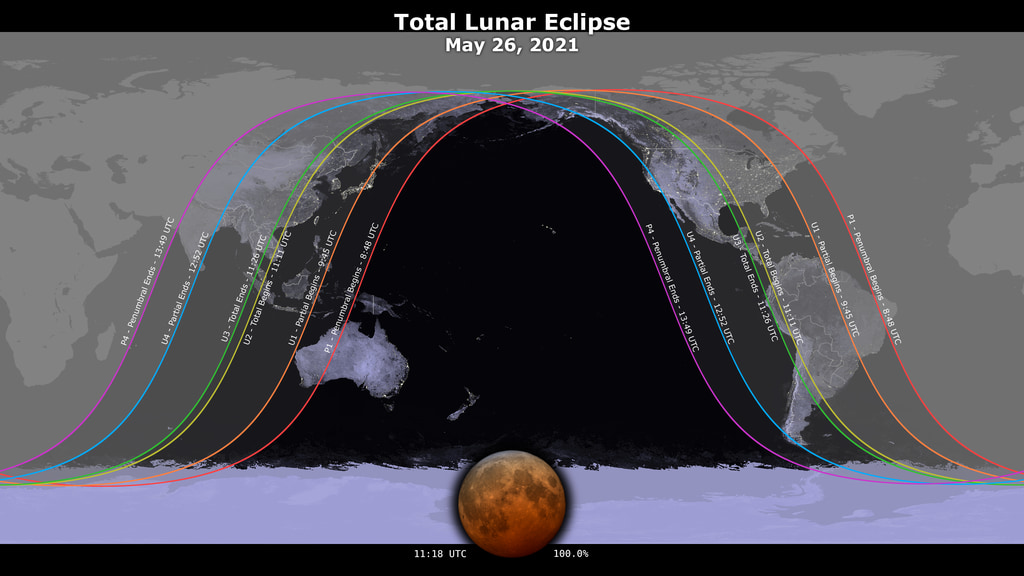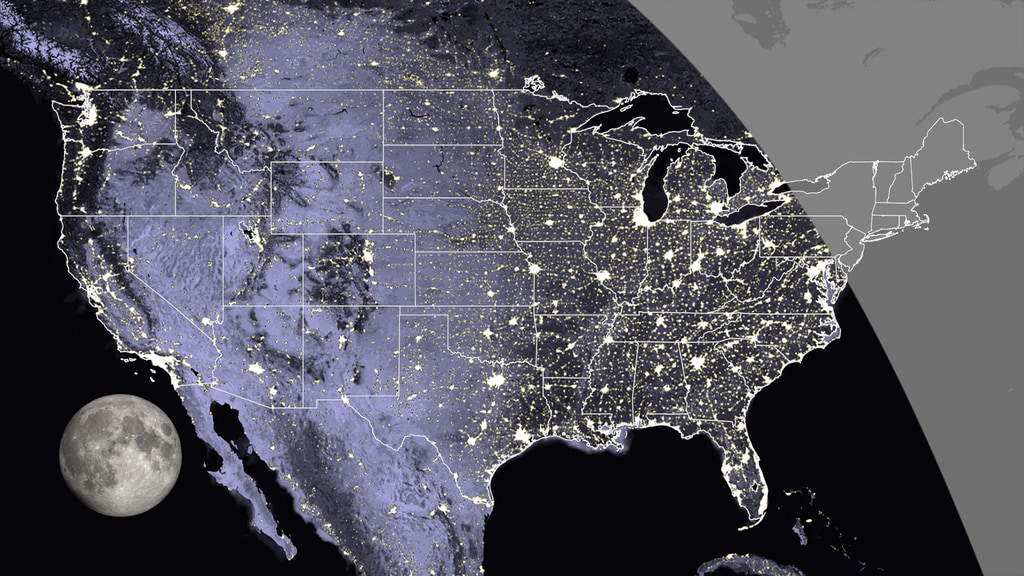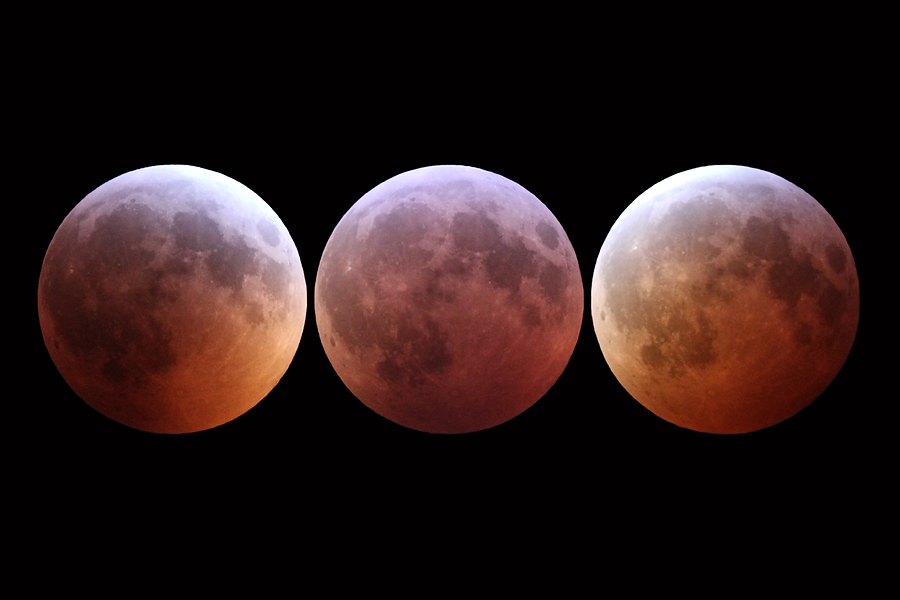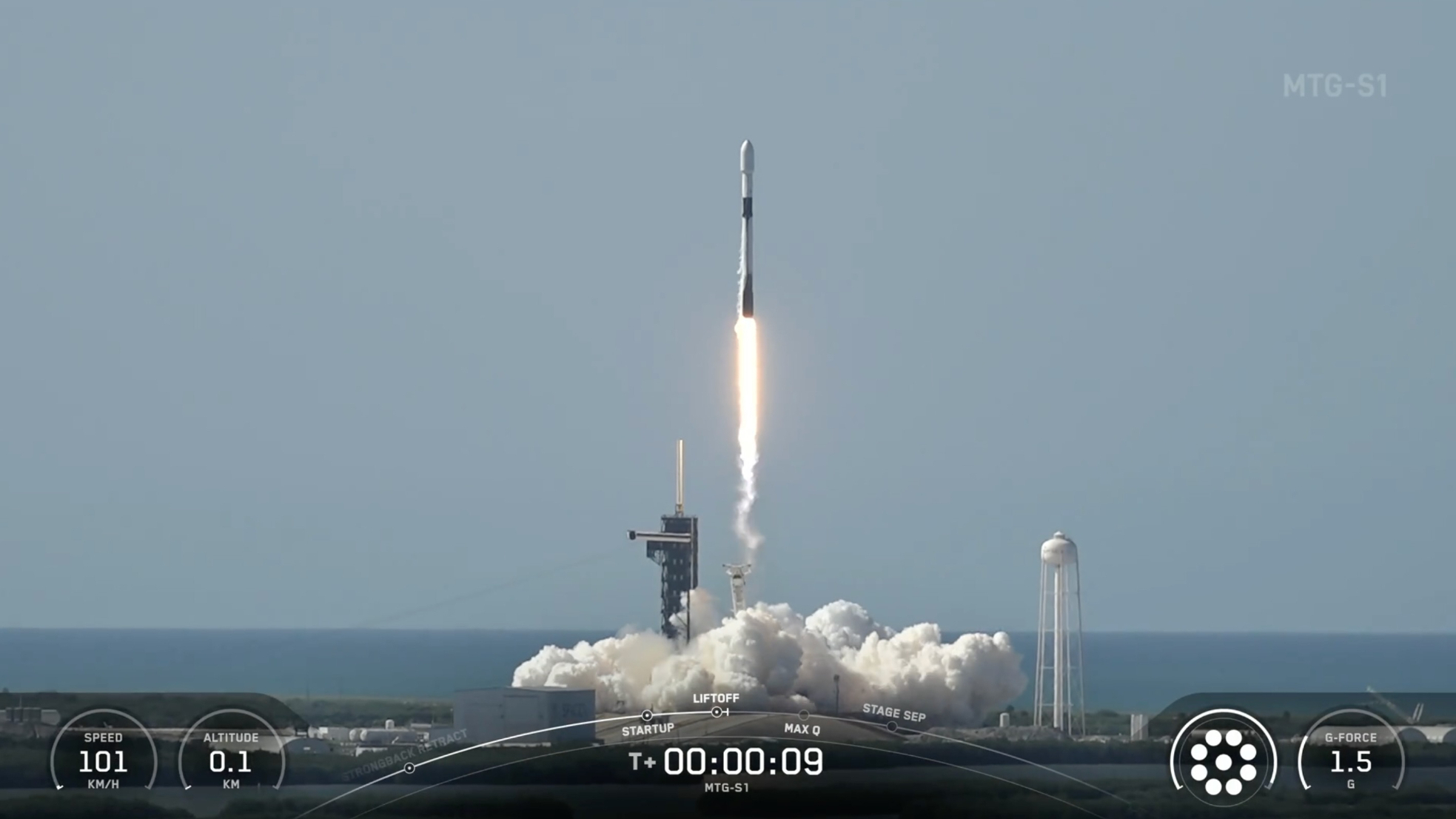Super Flower Blood Moon 2021: Where, when and how to see the supermoon lunar eclipse
It's the only total lunar eclipse of 2021!
Editor's note: The Super Flower Blood Moon lunar eclipse thrilled stargazers around the world and has ended. See photos, video and more in our wrap story here.
On the night of May 25-27, observers in Oceania, Hawaii, eastern Asia and Antarctica will see a lunar eclipse that coincides with the moon's closest approach to Earth — making it a "supermoon" eclipse that will turn the moon reddish — also known as a "blood moon." (The dates of this eclipse span two days because the area it will be visible spans the international date line).
Lunar eclipses occur when the moon is on the opposite side of the Earth as the sun. Usually we see a full moon when this happens, but every so often the moon enters the Earth's shadow, resulting in an eclipse. This doesn't happen every full moon because the plane of the moon's orbit is tilted about 5 degrees from the plane of the Earth's orbit, and the moon "misses" the shadow of the Earth.
Unlike a solar eclipse, which is only visible along a narrow track, lunar eclipses are visible from the entire night side of the Earth; this entire eclipse takes about five hours from start to finish. The timing depends a lot on what time zone you are in, relative to what is called Universal Coordinated Time (effectively the hour in Greenwich, England). In Asia, the eclipse occurs near moonrise in the evening. On the west coast of the Americas, the eclipse happens in the early morning hours, near moonset. The best viewing will be in between those two extremes: Australia, New Zealand, Hawaii, the islands of the South Pacific and southwestern Alaska.
Webcast info: How to watch the supermoon eclipse of 2021 online
Orion GoScope II 70 Telescope Moon Kit: $84.99 at Amazon
If you know a youngster who can't get enough of the moon, then they'll be delighted with views through the Orion GoScope II. Revealing craters and seas up close, this little telescope comes with a carry case and moon map.
This lunar eclipse will appear slightly larger than normal because the moon will reach perigee, the closest point in its orbit to Earth, on May 25 at 9:21 p.m. EDT (0121 May 26 GMT), some 14 hours after it is officially at full phase (which happens at 7:13 a.m. EDT, or 1113 GMT).
When the full moon and perigee are close, it is called a "supermoon" — though definitions aren't consistent as it isn't an astronomical term. Ordinarily the moon is an average of 240,000 miles (384,500 kilometers) from Earth, but its orbit isn't perfectly circular. So the distance varies slightly. When it reaches perigee this month, the moon will be 222,022 miles (357,311 km) from Earth, per Heavens-Above.com calculations. The moon does appear slightly larger when it is closer, but the difference is small, and it takes a very observant skywatcher to notice.
Breaking space news, the latest updates on rocket launches, skywatching events and more!
Related: The stages of the Super Flower Blood Moon explained
When is the Super Flower Blood Moon lunar eclipse?

The eclipse starts at 4:47:39 a.m. EDT (08:47:39 GMT), according to NASA's Eclipse Page. That's when the moon touches the penumbra. The partial phase of the eclipse starts about 57 minutes later, at 5:44 a.m. EDT (09:44:57 GMT). The moon enters the total phase of the eclipse at 7:11:25 EDT (11:11:25 GMT) and completes exiting the umbra at 10:52:22 EDT (12:52:22 GMT). Last contact is at 13:49:41. (To convert from GMT to your time zone you can use this converter).

If you take a cool photo of the 2021 total lunar eclipse let us know! You can send images and comments to spacephotos@space.com.
In Asia, the westernmost locations to see the eclipse are in India, Sri Lanka, western China and Mongolia, but only the penumbral phase will be visible. In Colombo, Sri Lanka for example, the moon rises at 6:23 p.m. local time on May 26, and the penumbral eclipse ends at 7:19 p.m. local time.
As one moves east more of the eclipse is visible. In Bangkok, the moon — which will already be deep in the Earth's shadow, appearing reddish — rises at 6:38 p.m. local time and the local maximum eclipse is three minutes later; the moon emerges from the umbra at 7:52 p.m. local time, and the penumbral eclipse ends at 8:49 p.m. local time.


From Tokyo, one can see the entire umbral phase of the eclipse just after moonrise at 6:37 p.m. local time. The moon will look slightly darker as the penumbral phase will have started already, and the moon touches the umbra at 6:44 p.m. local time. At that point, the moon will be turning red and just peeking over the horizon. The moon will be in the total phase of the eclipse, completely red, at 8:11 p.m. and greatest eclipse is at 8:18 p.m. local time. The total phase ends at 8:25 p.m. and the moon will leave the umbra at 9:52 p.m.; the eclipse ends at 10:49 p.m. local time.
The eastern two-thirds of Australia will see the entire eclipse. From Melbourne, the penumbral eclipse starts at 6:47 p.m. Australian Eastern Standard Time and the moon is already about 18 degrees above the horizon. The partial phase starts at 7:44 p.m. AEST and the total phase at 9:11 p.m. AEST. At that point, the moon is 45 degrees above the horizon — well above most obstructions. The total eclipse ends at 9:25 p.m. AEST and the umbral phase at 10:52 p.m. AEST. The penumbral phase ends near midnight, at 11:52 p.m. AEST.
For observers in the United States, the only places where the entire eclipse is visible are in Hawaii or Alaska. The table below lists several cities from which the entire umbral phase of the eclipse is visible, based on information from timeanddate.com and NASA's eclipse page. The cities are listed from west to east. Dates are noted when they change if one phase of the eclipse occurs after local midnight. Information is based on Time and Date.
| City | Moonrise | Penumbral begins | Umbral begins | Umbral ends | Penumbral ends | Moonset |
|---|---|---|---|---|---|---|
| Tokyo, Japan | 6:37 p.m. | Moon below horizon | 6:44 p.m. | 9:52 p.m. | 10:49 p.m. | 4:51 a.m. (May 27) |
| Sydney, Australia | 4:46 p.m. | 6:47 p.m. (May 26) | 7:44 p.m. | 10:52 p.m. | 11:49 p.m. | 7:20 a.m. (May 27) |
| Auckland, New Zealand | 5:02 p.m. | 8:47 p.m. (May 26) | 9:44 p.m. | 12:52 a.m. (May 27) | 1:49 a.m. (May 27) | 7:20 a.m. (May 27) |
| Honolulu, Hawaii | 7:55 p.m. (May 25) | 10:47 p.m. | 11:44 p.m. | 2:52 a.m. (May 26) | 3:49 a.m. (May 26) | 7:02 a.m. (May 26) |
| Anchorage, Alaska | 10:32 p.m. (May 25) | 12:47 a.m. (May 26) | 1:44 a.m. | 4:52 a.m. | Moon below horizon | 5:01 a.m. |
| San Francisco, California | 9:07 p.m. (May 25) | 1:47 a.m. (May 26) | 2:44 a.m. | 5:52 a.m. | Moon below horizon | 6:01 a.m. |
All times shown in local time zones.
Blood moon: Why a lunar eclipse moon turns red
The moon turns red because of the Earth's atmosphere. The atmosphere tends to scatter blue light — it's one reason the sky appears blue from the ground. As the Earth passes between the sun and moon, the light from the sun passes through the Earth's atmosphere and the blue light is scattered.
In addition, the light is refracted, or bent, and focused on the moon. In that sense, the Earth's air is like a giant lens. The light hits the moon and is reflected back to us — and we see the moon turn blood-red. From the point of view of a lunar observer, the Earth would eclipse the sun and be surrounded by a red ring of refracted sunlight.
Anatomy of the Super Flower Blood Moon eclipse

A lunar eclipse consists of six stages, the start of which are called "contacts." First contact (marked as P1 on charts) is when the moon touches the penumbra of the Earth. The penumbra is the part of the shadow that is lighter and only discolors the moon somewhat (it generally looks brownish-gray, or tea-stained, but the exact hue depends a lot on atmospheric conditions on Earth and one's own color perception). If one were standing on the moon, at first contact one would see the Earth approaching the sun but not quite blocking it yet — you'd see the dark side of the Earth, though.
Second contact is called U1, and that's when the moon touches the Earth's umbra — this is the dark part of the Earth's shadow, and that's when one sees the moon get a "bite" taken out of it. From the moon, one would see the Earth touching the sun, and blocking its light. This is also called the partial phase of the eclipse since the moon will be partially darkened.

The next stage is third contact, U2, when the trailing edge of the moon touches the edge of the umbra, this is the total phase of the eclipse. The moon is entirely within the Earth's darkest shadow at this point and turns a dark reddish color. From the moon, one would see the Earth completely covering the sun. Astronomers call this totality or total phase. After that comes the moment of greatest eclipse, when the moon is closest to the center of the umbra.
Fourth contact is U3, when the leading side of the moon touches the umbra, and the total phase of the eclipse ends. On the moon, you'd see the sun peek out from behind the Earth. Fifth contact is U4, and that's when the moon emerges from Earth's umbra. Finally, at sixth contact, P4, the moon emerges from the penumbra.
This whole event can last up to several hours, depending on how deeply the moon enters the Earth's shadow.
Legends of a total lunar eclipse
In Mark Twain's story "A Connecticut Yankee in King Arthur's Court" the time-traveling protagonist impresses King Arthur by his knowledge of the occurrence of a solar eclipse. In reality that wouldn't likely fool anyone at the time — Ptolemy had already worked out how to predict solar and lunar eclipses in 150 CE, some 300 to 400 years prior to the legendary Arthur's existence. Babylonian and Chinese astronomers also made sophisticated tables and calculations of eclipse timing as did the ancient Maya.
Lunar eclipses were easier to predict than solar eclipses because they are visible from anywhere on the night side of Earth. So if you're thinking of time traveling and bringing a lunar eclipse table to impress the natives, think again.
That said, eclipses were still seen as astrological agents of calamity; it's not uncommon to see legends of various creatures attacking the moon. For example, the Mesopotamians thought demons were attacking. Some cultures, such as the Hupa of northern California saw the lunar eclipse as an act of injury (hence the blood-red color) and renewal (as the moon healed and returned).
You can follow Space.com on Twitter @Spacedotcom.
Join our Space Forums to keep talking space on the latest missions, night sky and more! And if you have a news tip, correction or comment, let us know at: community@space.com.

Jesse Emspak is a freelance journalist who has contributed to several publications, including Space.com, Scientific American, New Scientist, Smithsonian.com and Undark. He focuses on physics and cool technologies but has been known to write about the odder stories of human health and science as it relates to culture. Jesse has a Master of Arts from the University of California, Berkeley School of Journalism, and a Bachelor of Arts from the University of Rochester. Jesse spent years covering finance and cut his teeth at local newspapers, working local politics and police beats. Jesse likes to stay active and holds a fourth degree black belt in Karate, which just means he now knows how much he has to learn and the importance of good teaching.

